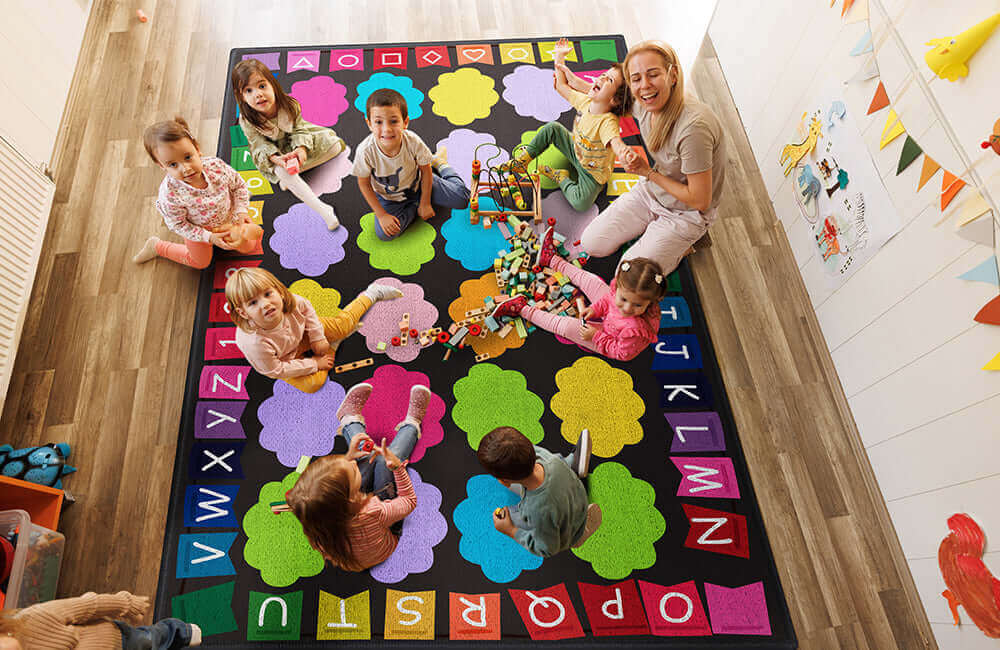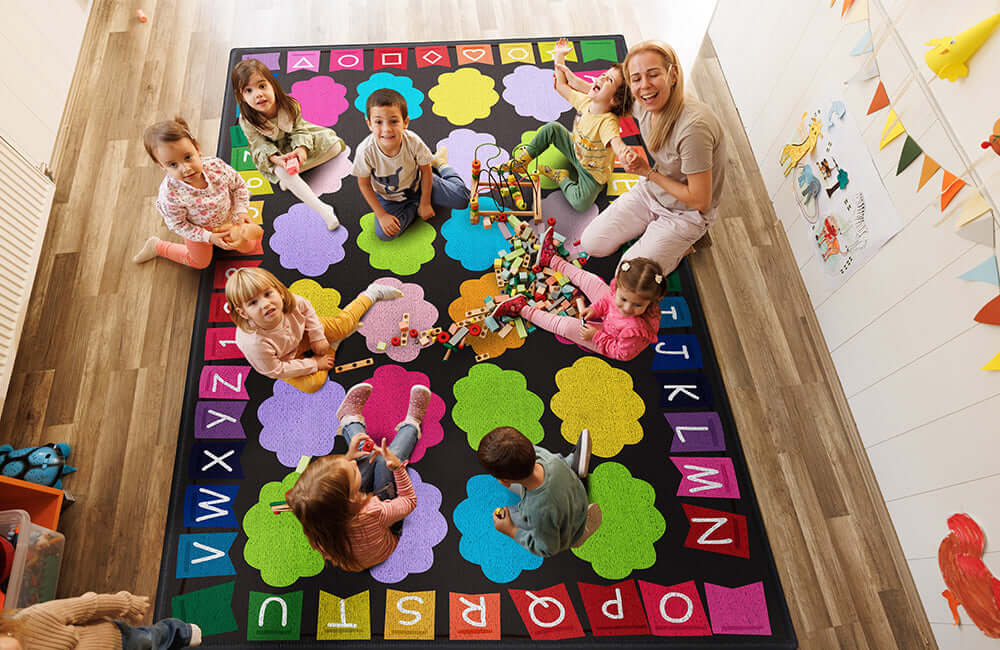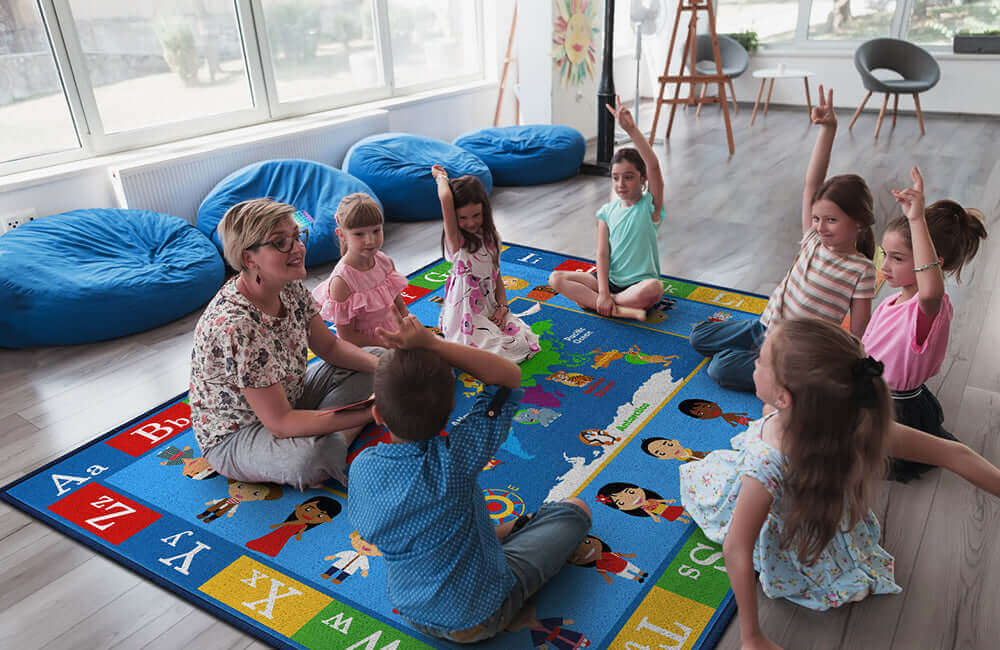The Psychology of Reading Spaces
Understanding the psychological impact of carpeted spaces provides a foundation for strategic literacy environment design:
Defining Psychological Boundaries
Carpets create:
- Visual cues that designate specific reading purposes
- Psychological permission to engage in literacy activities
- Non-verbal communication about expected behaviors
- Spatial definition that enhances focus and concentration
Creating Comfort and Security
Quality reading spaces offer:
- Physical comfort that extends engagement time
- Psychological safety for risk-taking in reading
- Sensory regulation supporting sustained attention
- Familiar, predictable environments that reduce cognitive load
Establishing Reading Identity
Well-designed carpeted areas contribute to:
- Student self-identification as readers
- Sense of belonging in literacy communities
- Positive associations with reading activities
- Ownership of personal literacy development
According to Reading Rockets, "The physical environment plays a critical role in defining reading experiences—carpeted areas specifically designated for reading communicate that literacy is valued and provide students with necessary psychological boundaries for deep engagement."
Strategic Carpet Zones for Literacy Development
Different literacy activities thrive in distinct environmental contexts:
The Gathering Carpet
Central classroom rugs support:
- Interactive read-alouds with clear sightlines to text
- Shared reading experiences with communal text access
- Literacy-focused morning meetings and circle time
- Whole-group phonics and vocabulary instruction
- Literature discussions and reader responses
Intimate Reading Nooks
Smaller carpeted areas enable:
- Sustained independent reading in comfortable spaces
- One-on-one reading conferences with teachers
- Paired reading partnerships in defined boundaries
- Small intervention groups with minimal distractions
- Reading-response activities in cozy environments
Specialized Literacy Stations
Strategic small rugs create:
- Listening centers with clear activity boundaries
- Word work stations with manipulative containment
- Puppet stages for retelling and comprehension activities
- Writing extension zones connected to reading
- Research stations for content literacy development
For specialized options designed for different literacy functions, explore our Literacy Environment Collection.
Carpet Features That Support Early Literacy
For emerging readers, specific carpet characteristics enhance literacy development:
Integrated Literacy Elements
Consider carpets featuring:
- Alphabet borders supporting letter recognition
- Word families or sight words for daily exposure
- Simple punctuation marks for environmental print
- Directional indicators reinforcing print concepts
- Narrative elements supporting story structure
Purposeful Positioning Features
Look for designs that include:
- Clear facing directions for optimal book viewing
- Teacher position indicators for read-aloud sessions
- Small group zones within larger carpeted areas
- Sufficient space for book display during sharing
- Room for both students and reading materials
Supportive Sensory Characteristics
Prioritize carpets with:
- Appropriate cushioning for extended sitting
- Textures that provide sensory feedback without distraction
- Sound absorption qualities enhancing read-aloud experiences
- Defined boundaries for material organization
- Patterns that support rather than compete with text
According to Wikipedia's entry on literacy environments, "Environmental print and thoughtfully designed physical spaces significantly impact emergent literacy development through consistent exposure to text features and creating dedicated contexts for literacy exploration."
Promoting Independent Reading Through Strategic Design
Developing lifelong readers requires environments that support voluntary reading engagement:
Creating Invitational Spaces
Independent reading thrives in carpeted areas that:
- Signal permission to relax conventional sitting expectations
- Provide comfortable alternatives to desk seating
- Create visual separation from instructional spaces
- Offer semi-private environments within public classrooms
- Include accessible book storage within the defined space
Supporting Sustained Engagement
Extended reading time requires:
- Sufficient cushioning for comfortable positioning
- Clearly defined personal space boundaries
- Minimal visual distractions in the carpet design
- Appropriate lighting integration with floor spaces
- Proximity to complementary literacy resources
Establishing Reading Rituals
Carpet areas enhance reading routines through:
- Consistent locations signaling reading expectations
- Physical transitions that prepare the mind for reading
- Environmental cues that trigger reading behaviors
- Spatial arrangements that minimize disruptions
- Material organization systems within defined boundaries
The International Literacy Association emphasizes that "The most effective independent reading environments combine physical comfort with clear boundaries, creating spaces where students choose to read beyond required instructional time."
Visit our Independent Reading Environment Guide for comprehensive recommendations on creating spaces that inspire voluntary reading.
Collaborative Literacy Spaces: Beyond the Reading Corner
Modern literacy instruction requires varied collaborative configurations:
Partner Reading Zones
Small carpet areas support:
- Defined spaces for paired reading activities
- Clear boundaries containing shared materials
- Intimate environments for peer discussion
- Semi-private zones for reading fluency practice
- Collaborative comprehension strategy application
Literature Circle Configurations
Dedicated carpets enhance literature discussions through:
- Clearly defined conversation boundaries
- Arrangements supporting equal participation
- Space for role materials and book organization
- Visual separation from other classroom activities
- Configurations promoting eye contact and engagement
Project-Based Literacy Areas
Flexible carpet spaces accommodate:
- Research material organization within boundaries
- Multimedia literacy project development
- Collaborative writing connected to reading
- Reader's theater rehearsal and performance
- Text-inspired creation and extension activities
According to Edutopia's research on collaborative learning, "Physically defined collaborative zones, particularly those with clear boundaries like carpeted areas, significantly increase both time-on-task and substantive peer-to-peer literacy interactions."
Supporting Diverse Learners Through Thoughtful Floor Spaces
Inclusive literacy environments require careful consideration of diverse learning needs:
Sensory Considerations
Support regulation through:
- Varied carpet textures for different sensory preferences
- Clearly defined boundaries for students needing explicit space definition
- Reduced visual stimulation in carpet patterns for focus challenges
- Position options accommodating different physical needs
- Noise reduction properties supporting auditory processing
Cultural Responsiveness
Enhance belonging through:
- Diverse text displays integrated with carpet spaces
- Cultural neutrality in carpet designs and patterns
- Multiple seating options honoring different cultural norms
- Space configurations supporting varied interaction styles
- Inclusion of multilingual environmental print when appropriate
Accessibility Factors
Ensure equity through:
- Clear pathways to carpeted literacy areas
- Sufficient space for mobility device navigation
- Multiple entry and exit points to reading spaces
- Stable surfaces for balance and transfer needs
- Positioning options for varying physical requirements
The National Center on Universal Design for Learning emphasizes that "Physical learning environments should provide multiple means of engagement through varied spatial arrangements that accommodate diverse learning preferences and needs."
Our Inclusive Classroom Design Guide provides comprehensive approaches to creating literacy spaces accessible to all learners.
Implementation Across Grade Levels
Effective literacy carpet strategies evolve alongside developing readers:
Early Childhood (PreK-K)
Prioritize spaces supporting:
- Exploration of book handling and print concepts
- Interactive read-alouds with clear text visibility
- Environmental print engagement and recognition
- Dramatic play connected to familiar texts
- Sensory experiences linked to reading development
Primary Grades (1-3)
Develop areas facilitating:
- Emergent reading in comfortable, defined spaces
- Small group differentiated instruction zones
- Word study and phonics practice stations
- Fluency development through repeated readings
- Initial comprehension strategy application
Upper Elementary (4-5)
Create environments enhancing:
- Sustained independent reading with diverse texts
- Literature discussion with textual evidence focus
- Content literacy and research processes
- Critical analysis and comparative reading
- Multimedia literacy response and creation
For grade-specific implementation guidance, explore our Developmental Literacy Environments resource collection.
Measuring Impact on Literacy Engagement
Evaluating the effectiveness of carpet-based literacy zones enables continuous improvement:
Observational Assessment
Monitor and document:
- Frequency of voluntary carpet area utilization
- Duration of engagement in carpeted reading spaces
- Student behaviors during different literacy activities
- Interaction patterns in collaborative carpet zones
- Material treatment and organization within defined spaces
Student Feedback Collection
Gather perspectives on:
- Comfort levels in different carpeted areas
- Preferences among various literacy spaces
- Self-assessment of focus in different environments
- Suggestions for environmental improvements
- Correlation between space and reading enjoyment
Literacy Outcome Connections
Analyze relationships between:
- Reading volume and carpet zone availability
- Comprehension development and environmental factors
- Discussion quality in different spatial arrangements
- Reading stamina in various carpet configurations
- Application of strategies across different spaces
Education researchers at The Reading Teacher note that "Classroom environment modifications, particularly those involving strategic floor space utilization, demonstrate measurable impacts on both quantitative reading metrics and qualitative engagement measures."
Conclusion
The thoughtful integration of carpets and rugs into literacy environments represents an often overlooked but powerful dimension of reading instruction.
By approaching floor coverings not merely as decorative elements but as strategic teaching tools, educators can create literacy-rich environments that enhance engagement, support diverse learning needs, and elevate reading experiences.
From the kindergartener experiencing their first read-aloud to the fifth grader deeply engaged in literature circles, students across developmental stages benefit from clearly defined, comfortable, purposeful reading spaces that communicate the value of literacy while supporting its varied expressions.
The humble classroom carpet, when selected and positioned with literacy development in mind, becomes a foundation upon which reading identities and competencies are built.
As you evaluate your current classroom literacy environment or plan future enhancements, consider how your floor spaces might be more strategically employed to support your reading instruction goals.
The investment in thoughtful carpet selection and placement often yields remarkable returns in student engagement, reading volume, and ultimately, literacy achievement.




Leave a comment
This site is protected by hCaptcha and the hCaptcha Privacy Policy and Terms of Service apply.